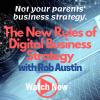Business Transformation Requires Transformational Leaders
Leadership and teaming skills are front and center in times of rapid change. Meet today’s constant disruption head on with expert guidance in leadership, business strategy, transformation, and innovation. Whether the disruption du jour is a digitally-driven upending of traditional business models, the pandemic-driven end to business as usual, or the change-driven challenge of staffing that meets your transformation plans—you’ll be prepared with cutting edge techniques and expert knowledge that enable strategic leadership.
Recently Published
There is a giant universal mental challenge when it comes to agilifying. Yet the goal of the modern organization is to rebuild itself all the time. Agility can mean different things to different people, and it should. Still, it is important to vividly understand its various meanings and to allow the organization to be aware of these meanings and then prioritize them. This Advisor offers some concrete ways in which we can both shift our perspectives and act to “agilify” our organizations.
Much of the wisdom, books, academic papers, and so on, concerning Agile, focus at the team level. Yet an Agile transformation focuses on the adoption of Agile principles at the business or organizational level. Agile transformation, therefore, presents senior leaders with challenges they need to work out for themselves without such recommendations. The temptation is to reach out to their traditional business advisors; however, as this Executive Update illustrates, this may not be the optimal path.
Many organizations are now focusing on a hybrid cloud strategy: moving part of their IT capabilities to the cloud, while maintaining core elements in-house, hosted on-premises. The hybrid model is becoming immensely customary among organizations, as it enables them to optimally allocate their resources while keeping their current IT infrastructure operating at low risk. A hybrid cloud strategy not only prepares an organization for the future but also protects its investment today.
The way we do business is transforming. It’s being pushed and pulled by many factors, most notably by a younger workforce demanding new interfaces and services necessary to perform jobs their way. At the heart of every digital transformation project is an immutable pain wrapped in competing motivations: doing more, doing it faster, and avoiding missed opportunities. How can we reconcile these motivations in our day-to-day business? When we discuss the concept of “a culture transformed,” we can draw many parallels against the way a society votes and spends, but that’s out of scope. What is not out of reach is your influence over your teams and whether you can embrace the change that is upon us all. It’s up to you to set the tone of the conversation within the organization: robots aren’t here to steal our livelihoods; they’re here to make us more productive and lighten the load, right?
Disruptive changes within a company can result either in a spectacular rise if done right or an abrupt decline if not handled well. People are at the center of every change. If employees do not connect with their organization, do not see the need for change, do not buy in to the leadership’s vision, or are not motivated, any change will fail. For employees to see value beyond the defined work parameters, they need to feel connected to the company. Connection, respect, and trust will help a company maintain employee support for the changes that a company wants to implement. In this Advisor, we discuss in brief two such initiatives that brought about drastic increases in employee support and participation.
In this Advisor, we explore the benefits of a promising breakthrough growth model that we have successfully applied in both B2C and B2B businesses. This model delivers major benefits in terms of speed, cost, and likelihood of success. It involves radical collaboration across the innovation ecosystem and covers the entire innovation process from idea to commercialization, including the strategic, commercial, operational, and technical aspects. We call this the Breakthrough Incubator (BI) model. The BI model enables accelerated creation of a new business proposition with new products/services externally — before transitioning it back into the parent organization, thereby overcoming many of the prototype scale-up barriers. In essence, this is the “build, operate, transfer” philosophy applied specifically to innovation and product development.
Recently, the Cutter Consortium editor who facilitates this Advisor series sent me a set of questions frequently asked about Agile transitions. Among the ones I found most intriguing wasn’t really a question but merely a statement, claiming: “Misunderstanding on the part of teams that Agile allows for less discipline, leading to less precise delivery schedules.” There are several elements of this statement that I encounter frequently, so I decided to use it as a basis for this article.
In this on-demand webinar, Cutter Consortium Fellow and Ivey Business School Professor Robert D. Austin lays out the new digital business strategy map. He talks about new rules and new realities that you need to know to proof your business against disruption in a “hub" or “platform" economy. Rob’s objective is to help you down a path toward equipping all your managers for survival in a digitally transformed world.
























